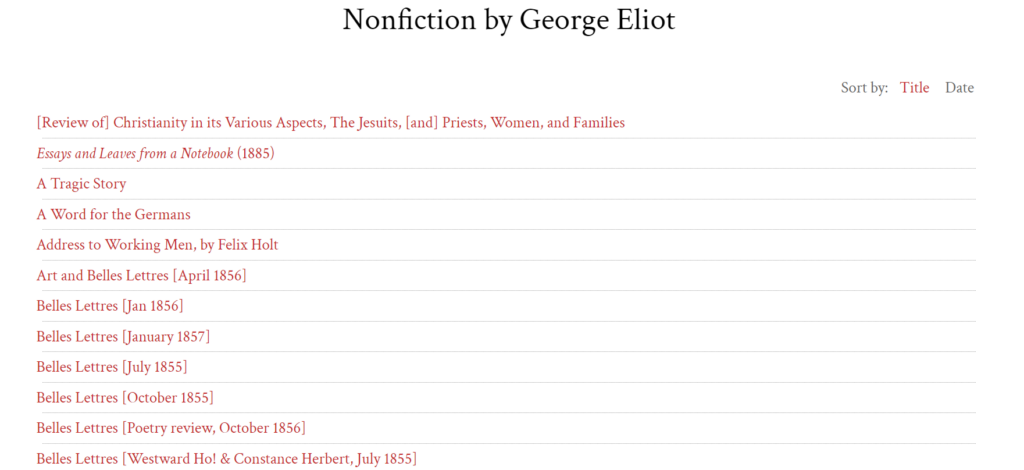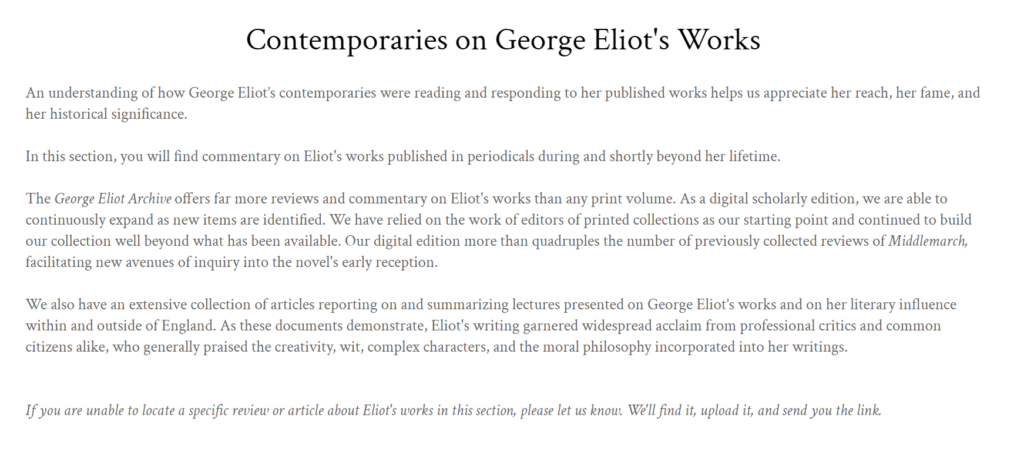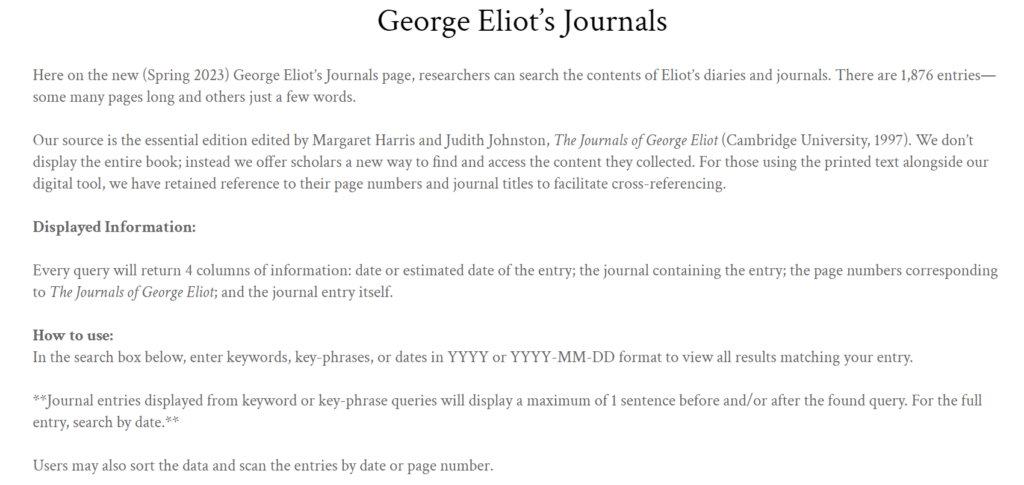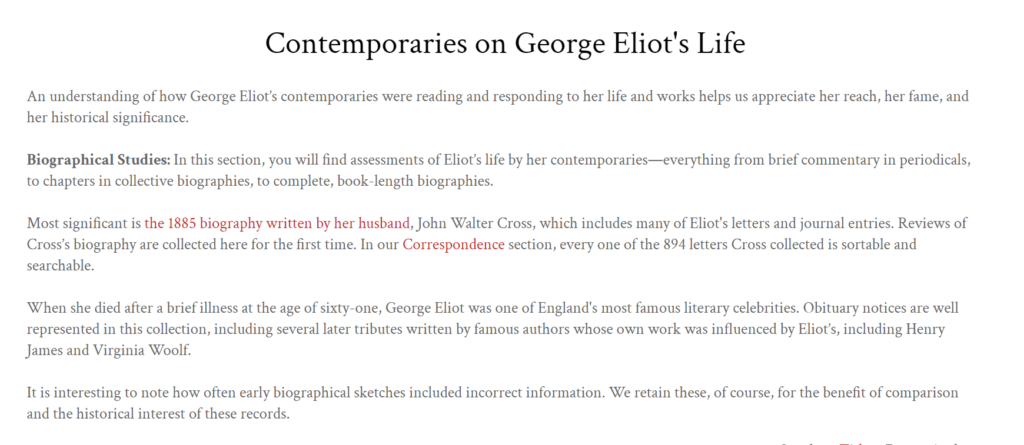URL: https://georgeeliotarchive.org/
The George Eliot Archive is a digital archive which allows a gateway to the life and works of one of the most celebrated Victorian authors, George Eliot. In this review, we will delve into the intricacies of this digital media site, evaluating its content, usability, accessibility, and overall impact. As we navigate through the website, we uncover George Eliot’s literary genius and historical significance. When exploring the website you will find that The George Eliot Archive demonstrates exceptional effectiveness, usability, and information storage capabilities, making itself a great digital resource for scholars, students, and enthusiasts of Victorian literature.
Who is this site for?
The George Eliot Archive caters to a diverse audience, offering valuable resources for scholars, students, researchers, and enthusiasts interested in the life and works of George Eliot.
Students pursuing coursework in English literature, history, or related fields can also access significant educational value from the site to deepen their understanding of Eliot’s writings and historical context. Furthermore, educators may find the archive to be a valuable teaching tool, incorporating its materials into their curriculum to enrich classroom discussions and assignments.
Beyond the academic community, the archive may also appeal to general readers with an interest in Victorian literature and culture, providing accessible and engaging insights into Eliot’s life and works. Enthusiasts and fans of Eliot’s writing may find the archive to be a treasure of information and resources, enhancing their appreciation and enjoyment of the litereary works.
Overall Usability and Design
Upon entering the George Eliot Archive website, visitors are greeted by a clean and well-organized interface that immediately draws attention to the vast amount of resources available. The homepage offers a directory into the diverse sections of the archive, including biographical information, published literary works, unpublished literary works, images, and more. The layout is intuitive, with clear navigation menus and simple search functionality, making it easy for users to explore the site and access the content they seek.
Things to note about the homepage below 
- Photograph of George Eliot is easily visible and fits with the website aesthetic
- Easily accessible search bar highlighted top right
- Easily accessible Directory above George Eliot photo which clearly tells you what this archive consists of.
The George Eliot Archive excels in providing a seamless user experience. The minimalist design of the George Eliot Archive serves as a testament to the site’s commitment to simplicity and functionality. Embracing the principles of minimalism, the design refrains from unnecessary design elements and distractions in favor of restrained use of color, and uncluttered layout. The site has a visually calming interface with a lot of white space and a conservative/traditional typography.
In addition to enhancing usability, the minimalist design contributes to the site’s aesthetic appeal, creating a sense of elegance and sophistication that is suited for a scholarly resource. The conservative use of color accents adds visual interest without overwhelming the user and distracting from the overall simplicity of the design.
Overall, the minimalist design of the George Eliot Archive assists in prioritizing clarity, functionality, and user experience above all else. By embracing simplicity in both form and function, the site achieves a desirable balance between aesthetics and usability, making it a pleasure to explore for users of all backgrounds and levels of expertise.
Interactive Data
One of the standout features of the George Eliot Archive is its innovative approach to presenting historical materials in a digital format. The website utilizes interactive elements such as timelines, maps, and multimedia exhibits to bring Eliot’s world to life and engage users in a dynamic exploration of her life and works. These innovative features not only enhance the user experience but also offer new avenues for scholarly research and interpretation.
Below is an example of an interactive map featured on the website. You can visualize, travel around the map, and click on all of the significant locations of George Eliot’s life with a little summary of each.

Beyond its scholarly value, the interactive map also enhances user engagement and accessibility. Its intuitive interface and user-friendly navigation tools make it accessible to users of all ages and levels of digital literacy. Whether browsing on a desktop computer or a mobile device, users can seamlessly explore the map’s features and discover new insights into Eliot’s world with ease.
Another example of interactive data featured on the website is the text explorer. Below you will see a screengrab of the text explorer page from the website. Highlighted are the search bar and drop down menu for different literary works. Its comprehensive search functionality allows users to search across Eliot’s entire body of work with precision and ease.
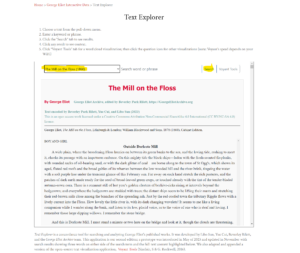
In addition to its search capabilities, the Text Explorer offers annotation and analysis tools that help users to engage with Eliot’s texts in new and meaningful ways. Users can annotate passages, highlight key phrases, and add personal notes. This can help to foster a deeper level of engagement with the text and facilitate collaborative research efforts. There’s even more, the Text Explorer has analytical tools such as word frequency charts, alphabetical display of words, and analysis algorithms, which can help users to uncover patterns, trends, and insights within Eliot’s writings that may have otherwise gone unnoticed.
The interactive data features on the George Eliot Archive website can accomplish something that other forms of media are incapable of doing. Through dynamic visualizations, interactive maps, and analytical tools, this digital project in particular offers users a unique and immersive way to engage with George Eliot’s literary works. Unlike traditional print media or plain digital formats, the interactive data on the website allows users to explore Eliot’s texts in a more thorough way, uncovering hidden patterns, connections, and insights that would be more difficult to do through conventional forms of media.
Overall Content Overview
Manuscripts and Documents:
One of the standout features of the archive is its extensive collection of George Eliot’s manuscripts and documents. Users can view Eliot’s handwritten letters, notebooks, and drafts, gaining unprecedented access to the author’s creative process and personal correspondence. These writings offer valuable insights into Eliot’s literary techniques and thought process, providing a deeper understanding of her works.
Critical Essays and Commentary:
In addition to primary source materials, the archive also hosts a range of critical essays and scholarly commentary on George Eliot’s life and writings. These contemporaries cover various aspects of Eliot’s body of work, including her narrative techniques and social context. Whether exploring Eliot’s “Middlemarch” or analyzing her engagement with nineteenth-century intellectual currents, users can find a vast amount of analysis to enhance their appreciation and understanding of her work.
Biographical Information:
For those interested in learning more about George Eliot’s life, the archive provides comprehensive biographical information, including timelines, bibliographies, and images. Users can trace Eliot’s evolution from her early years as Mary Ann Evans to her emergence as one of the most celebrated novelists of the Victorian era. By contextualizing Eliot’s life within the broader historical and literary landscape, the archive deepens our understanding of the woman behind the pen.
Conclusion
In conclusion, the content offered by the George Eliot Archive is both extensive and diverse, catering to a wide range of interests and scholarly pursuits. The George Eliot Archive is an example of a digital project that makes the furthering of understanding and appreciation of a topic effortless for the user. With its wealth of resources, intuitive design, and innovative features, the archive offers a captivating journey into the life and works of George Eliot, leaving a lasting impact on scholars, students, and enthusiasts alike.
